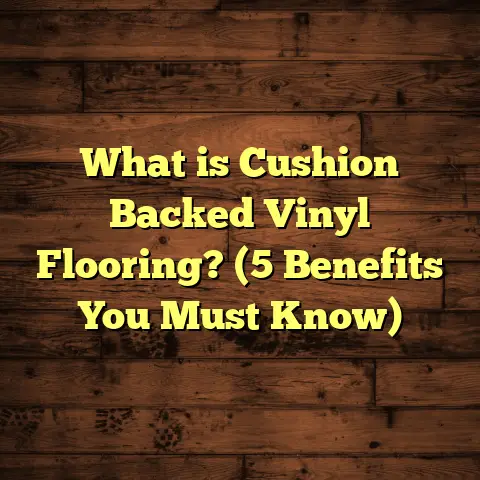What is Vinyl Flooring Glue? (5 Tips for Perfect Installation)
Spring is here, and it’s that time when I feel the urge to refresh and renew my home. The days get longer, flowers bloom, and suddenly, the worn-out look of my floors stands out way too much. So, I recently took on a vinyl flooring project. If you’ve ever thought about updating your floors with vinyl—or you’re in the middle of it—you might have bumped into the question: “What exactly is vinyl flooring glue?” It sounds straightforward, but there’s quite a bit to unpack. Let me share my journey, lessons learned, challenges faced, and some tips that can make your installation smoother.
What Is Vinyl Flooring Glue?
At its core, vinyl flooring glue is a specially formulated adhesive designed to bond vinyl flooring materials to a subfloor securely. But it’s not just “any glue.” Vinyl flooring glue has unique properties to match the demands of vinyl flooring.
Vinyl itself is a flexible, resilient plastic material that can expand and contract slightly with temperature changes. The glue needs to accommodate that movement without breaking down or losing its grip. Plus, it should resist moisture because vinyl floors are often installed in areas prone to humidity—think kitchens, bathrooms, basements.
Types of Vinyl Flooring Glue
There are several types of adhesives tailored for different vinyl flooring styles:
- Pressure-Sensitive Adhesive (PSA): This type remains tacky after application and lets you reposition tiles or sheets during installation. Once pressure is applied, it forms a strong bond. I’ve found PSA glue especially helpful when working with vinyl tiles since they aren’t always perfectly square or uniform.
- Wet Adhesive: This glue requires spreading on the subfloor and then drying to a tacky state before laying down vinyl. It creates a very strong bond but demands precise timing and environmental control. Wet adhesives are often used for sheet vinyl.
- Solvent-Based Adhesive: Less common now due to fumes and environmental concerns, these adhesives offer strong bonds but require careful ventilation during installation.
- Acrylic-Based Adhesive: These water-based adhesives are more environmentally friendly and have lower odor. They’re gaining popularity and provide good adhesion for various vinyl products.
How Does Vinyl Flooring Glue Work?
When applied correctly, the adhesive forms a layer between the vinyl material and the subfloor. It fills in microscopic gaps ensuring no air pockets or loose spots. The glue’s flexibility accommodates slight movements caused by foot traffic or temperature shifts.
The bond strength depends on several factors:
- The adhesive type and quality.
- The condition and type of subfloor.
- Installation environment (temperature and humidity).
- Proper application thickness and technique.
I’ve learned that even the best glue can fail if any of these aren’t right.
Why Vinyl Flooring Glue Matters So Much
You might wonder why so much focus is put on glue when installing vinyl flooring. After all, isn’t the vinyl itself what you’re paying for? Here’s why adhesive choice matters:
- Durability: A strong bond prevents curling edges or tiles lifting over time.
- Moisture Resistance: Prevents water from seeping under floors causing mold or damage.
- Appearance: Proper adhesion avoids bubbles or wrinkles that ruin the floor’s look.
- Longevity: A well-adhered floor lasts years without needing repair or replacement.
In one of my early projects, I grabbed an inexpensive adhesive thinking all glues were basically the same. Within months, edges curled up in a high-moisture laundry room. That experience taught me the hard way how vital it is to match your adhesive to your floor type and environment.
My Personal Experiences with Vinyl Flooring Adhesive
Let me share some real-life stories from my own projects to give you a clearer picture.
Kitchen Makeover: Patience Pays Off
A couple of years ago, I decided to replace old linoleum in my kitchen with new vinyl tiles. I chose a pressure-sensitive adhesive because I wasn’t sure about tile placement and wanted some wiggle room.
Applying the glue with a notched trowel gave me an even spread. But I remember how critical it was to keep the area dust-free and avoid walking on freshly glued sections until they adhered well. I spent extra time aligning tiles perfectly since PSA glue lets you reposition before setting.
The result? A smooth, flawless floor that still looks great two years later with no edges lifting or bubbles forming despite heavy kitchen use.
Basement Blues: When Moisture Wins
On another job in a client’s basement, we used wet adhesive on sheet vinyl. The basement had some unnoticed moisture seepage through the concrete slab. Despite sealing the floor beforehand, after about six months we noticed sections lifting and bubbling.
It was frustrating because wet adhesive usually performs well in sheet vinyl installations. But excess moisture compromised the bond. This project taught me to test moisture levels more rigorously before choosing adhesive types.
Common Challenges with Vinyl Flooring Glue (And How I Handle Them)
Working with vinyl flooring glue isn’t always smooth sailing. Here are some challenges I’ve faced repeatedly along with practical solutions:
1. Moisture Problems
Moisture is the biggest enemy of adhesives. Subfloors like concrete slabs can retain water vapor that slowly seeps through.
How I handle it:
Before installation, I always test moisture levels using a calcium chloride test or moisture meter. If moisture is above recommended levels (usually 3 lbs/1000 sq ft/24 hours for concrete), I either delay installation or use moisture barrier primers designed for high moisture.
2. Uneven Subfloor Surfaces
Vinyl glue needs a flat surface to bond properly; bumps or cracks cause bubbles.
My approach:
I spend time smoothing out imperfections using patching compounds or self-leveling underlayment. It adds effort upfront but saves headaches later.
3. Temperature Sensitivity
Cold weather can thicken glue; hot weather can cause it to dry too quickly.
Tip:
Maintain room temperature between 65°F and 85°F during installation (check product specs). On cold days, I warm adhesives slightly indoors before use.
4. Incorrect Application Thickness
Too thin = weak bond; too thick = glue seepage and messy cleanup.
What works for me:
Using manufacturer-recommended notched trowels ensures consistent adhesive thickness. I also keep extra rags handy to clean excess immediately.
5. Inadequate Curing Time
Walking on floors too soon can cause shifting or bubbling.
From experience:
I block off installed areas for at least 24–48 hours depending on glue type before heavy traffic or furniture placement.
The Science Behind Adhesive Performance
You might be curious about what actually makes vinyl flooring glues work so well—or fail under certain conditions.
Adhesion Mechanism
Adhesives work through mechanical bonding and chemical bonding:
- Mechanical Bonding: The glue seeps into tiny pores or roughness on the subfloor surface creating a physical lock.
- Chemical Bonding: Molecular attraction between adhesive polymers and vinyl molecules forms stronger bonds.
Good adhesives balance both mechanisms while remaining flexible to handle expansion/contraction cycles typical in vinyl floors.
Environmental Factors Affecting Adhesion
A controlled environment is crucial:
- Humidity: High humidity slows drying of wet adhesives but may weaken bonds if excessive.
- Temperature: Extreme cold thins viscosity; extreme heat speeds up drying causing poor wetting.
- Air Circulation: Proper ventilation helps solvent-based adhesives dry evenly but must be balanced to avoid over-drying.
Data from Industry Testing
According to tests by the Tile Council of North America (TCNA):
| Test Condition | Bond Strength (psi) | Failure Mode |
|---|---|---|
| Dry Concrete Subfloor | 150+ | Cohesive failure |
| Moisture-Exposed Concrete | 70–90 | Adhesive failure |
| Uneven Subfloor | <50 | Delamination |
This shows how moisture and uneven surfaces drastically reduce bond strength—validating my insistence on thorough prep work.
Cost Considerations: How I Use FloorTally for Budgeting
Budgeting can be tricky when planning floor installations. You want quality materials but don’t want surprises mid-project from hidden costs like wasted adhesives or labor overruns.
I’ve found FloorTally incredibly helpful for managing this part of my work. It lets me:
- Input room dimensions accurately.
- Select specific types of vinyl flooring and adhesives with local price data.
- Factor in waste percentages (usually around 5-10% for cutting errors).
- Get clear cost breakdowns separating materials and labor.
- Adjust selections on the fly to see how changes affect total cost.
For example, during my kitchen project:
- Room Size: 200 sq ft
- Vinyl Tiles: $2/sq ft
- Pressure-Sensitive Adhesive: $0.60/sq ft
- Labor: $3/sq ft
FloorTally estimate showed me a total of about $720 for materials plus $600 labor—helping me plan purchases without overbuying or underestimating labor time.
By using such tools regularly, I avoid budget surprises and can present clients with realistic quotes upfront.
Step-by-Step Installation Walkthrough With Glue
To help you visualize what I do on an installation day, here’s my typical process:
Step 1: Subfloor Inspection & Prep
I always start by checking for moisture levels and surface smoothness. Any cracks or holes get filled with patch compound; dust is vacuumed thoroughly.
Step 2: Acclimate Materials
Vinyl flooring and adhesive need to sit in the room for at least 24 hours at room temperature to minimize expansion/contraction after installation.
Step 3: Layout Planning
I measure carefully and create chalk lines as guides so tiles or sheets line up evenly—no surprises at edges or corners.
Step 4: Apply Adhesive
Using a notched trowel, I spread pressure-sensitive adhesive evenly over small sections (about 4×4 feet), avoiding drying out before laying vinyl.
Step 5: Place Vinyl
I carefully place tiles or sheets onto the glued area, pressing firmly with a roller or hand pressure for full contact.
Step 6: Clean Excess & Repeat
Any glue squeezed out is wiped immediately with a damp cloth to avoid sticky messes. Then I move to next section until done.
Step 7: Final Roll & Curing
Once all vinyl is down, I roll over the entire floor with a heavy roller to ensure even adhesion and let it cure undisturbed for at least 24 hours.
Frequently Asked Questions About Vinyl Flooring Glue
Here are some questions I get asked often:
Can I use regular wood glue for vinyl floors?
No! Wood glues won’t provide the flexibility or moisture resistance needed for vinyl flooring. Always use adhesives specified for vinyl flooring types.
How long does vinyl flooring glue take to dry?
Drying times depend on adhesive type—from minutes for pressure-sensitive glue to several hours for wet adhesives before laying down vinyl.
Is it okay to install vinyl floors over old adhesive?
Usually not recommended unless you remove old adhesive completely because it can interfere with bonding new glue.
Can I install vinyl floors myself?
Yes, many homeowners can do it successfully with careful prep and following instructions—especially using pressure-sensitive tile adhesives that allow repositioning.
Final Thoughts From My Experience
Over years of installing vinyl floors across different homes and commercial spaces, learning about adhesives has been key to success. The right glue combined with careful preparation creates floors that last years without issues.
If you’re planning a project:
- Test moisture first.
- Choose adhesives matched to your flooring type.
- Follow product instructions closely.
- Don’t rush curing times.
- Use tools like FloorTally to keep your budget realistic.
What about you? Have you tried installing vinyl floors? Hit any snags? Or maybe you’re gearing up for your first project? Feel free to ask me anything about adhesives or installation—I’m glad to share what worked (and what didn’t) from my own hands-on experience!





